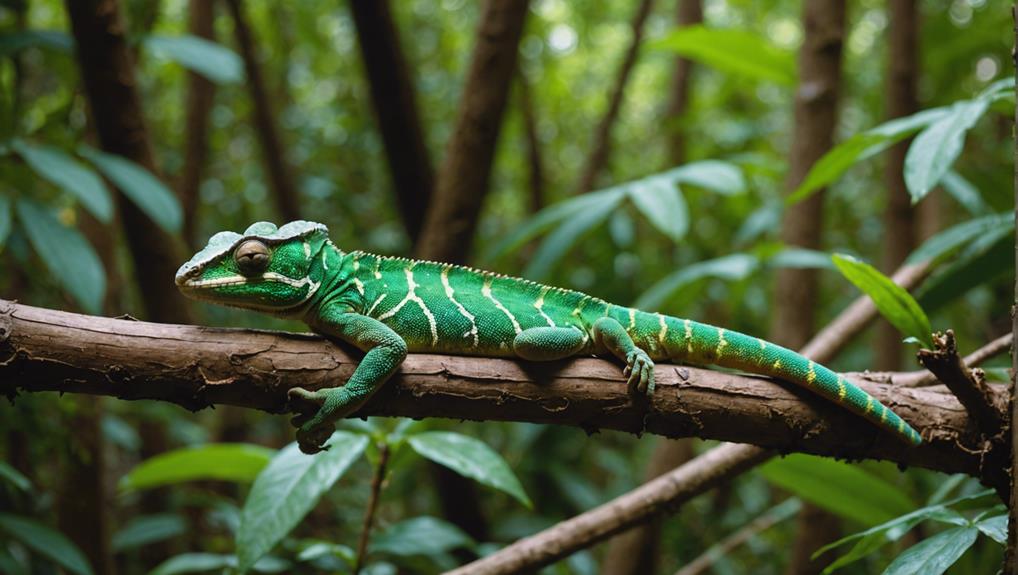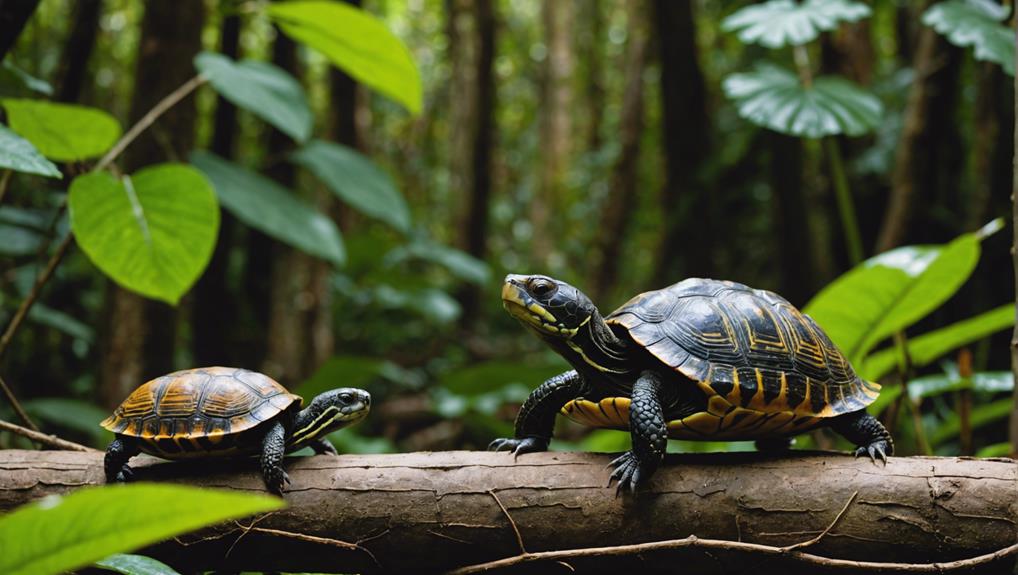Madagascar's reptiles have evolved astonishing adaptations to thrive in the island's unique ecosystems.
Chameleons change color to blend in and communicate, thanks to specialized skin cells called chromatophores. Geckos use skin flaps and patterns to merge with their surroundings. Tortoises sport specially adapted shells that provide protection, collect water, and offer camouflage.
Arboreal reptiles like chameleons and leaf-tailed geckos possess prehensile tails and sticky toe pads, perfect for tree life.
In the desert, reptiles like geckos become nocturnal, minimizing water loss and avoiding scorching heat.
Burrowing provides a cool refuge from the harsh conditions.
These adaptations demonstrate the remarkable ways Madagascar's reptiles have adapted to their environments.
Chameleon Coloration
Madagascar's chameleons are renowned for their vibrant coloration, which they use for communication and camouflage. When you're exploring the wild landscapes of Madagascar, you'll notice how these reptiles blend seamlessly into their surroundings or stand out in brilliant displays. Each color shift isn't just random; it's a well-calculated move that serves a specific purpose.
Chameleons change color by altering the special cells in their skin called chromatophores. These cells contain different pigments and, by expanding or contracting, they mix these pigments to produce the vivid colors you see. This ability is essential for their survival. When a chameleon feels threatened, it can quickly switch to colors that match its environment, making it nearly invisible to predators. On the flip side, during social interactions, like attracting a mate or warding off rivals, you'll see them flaunt bright, eye-catching hues.
You might think that chameleons change color to match any background instantly, but that's not entirely true. Their color range is somewhat limited by their species and the pigments they have. So, while they can't mimic every single color in their environment, they do an excellent job within their capabilities.
What's fascinating is that the color changes are also influenced by temperature, light, and even the chameleon's emotional state. If you're observant, you might notice that a stressed chameleon may turn darker, while a calm one might show lighter, more vibrant colors. This dynamic use of color makes chameleons one of the most adaptable and intriguing creatures in Madagascar, perfectly suited to thrive in its diverse and ever-changing ecosystems.
Gecko Camouflage
Geckos in Madagascar have mastered the art of camouflage, blending seamlessly into their surroundings to evade predators and surprise prey. These reptiles possess an incredible ability to change their skin color and pattern to match the textures and hues of their environment. Whether it's the bark of a tree, the surface of a rock, or the leaf litter on the forest floor, geckos can adjust their appearance to stay hidden from both hunters and the hunted.
One of the most fascinating aspects of gecko camouflage is the variety of mechanisms they employ. Some geckos have skin that mimics the rough texture of tree bark, while others have patterns that resemble leaves. This ability isn't just about changing color; it's about replicating the specific details of their environment to virtually disappear.
Here's a breakdown of how different gecko species use camouflage:
| Gecko Species | Camouflage Mechanism |
|---|---|
| Uroplatus fimbriatus | Skin flaps and coloration mimic tree bark |
| Phelsuma madagascariensis | Vivid colors blend with bright foliage |
| Uroplatus phantasticus | Tail and body shape resemble dead leaves |
You'll find that these adaptations not only help geckos avoid becoming a meal but also make them highly effective ambush predators. By staying perfectly still and blending in, they can wait for the perfect moment to strike unsuspecting insects or other small creatures.
In Madagascar's diverse ecosystems, the freedom to adapt is essential for survival. Geckos have embraced this need with their remarkable camouflage abilities, showcasing the incredible diversity and ingenuity of life on this island. Their ability to blend in so perfectly is a demonstration of the power of evolution and adaptation.
Tortoise Shell Adaptations
When it comes to tortoises in Madagascar, their unique shell adaptations play a pivotal role in their survival. In the island's diverse and sometimes harsh environments, these tortoises have evolved shells that offer more than just protection from predators. You'll find that these shells are specially designed to help them navigate and thrive in their specific habitats.
The shape of a tortoise's shell can tell you a lot about its lifestyle. For instance, the ploughshare tortoise, native to Madagascar, has a high-domed shell. This design helps it move through dense underbrush with ease, as the rounded shape allows it to push aside obstacles. In contrast, other tortoises with flatter shells might inhabit more open areas where such navigation isn't necessary.
The shell also acts as a water collection system. During Madagascar's dry seasons, water can be scarce. Tortoises have adapted by using their shells to collect and funnel rainwater directly into their mouths. This adaptation is essential for their hydration and overall survival.
Additionally, the coloration of the tortoise shell provides excellent camouflage. Blending into the varied landscapes of Madagascar, from forests to scrublands, these shells help tortoises avoid detection by predators. The colors and patterns often mirror the environment, offering an extra layer of protection.
Lastly, the shell's strength and thickness are tailored to fend off specific threats. For example, the radiated tortoise has a particularly hard shell to deter attacks from predators like birds of prey.
Understanding these shell adaptations gives you a clearer picture of how Madagascar's tortoises have mastered their unique environment. Their shells aren't just armor; they're multi-functional tools essential for their survival in one of the world's most unique ecosystems.
Arboreal Habits
Beyond the ground-dwelling tortoises, Madagascar's forests host a variety of reptiles with fascinating arboreal habits, demonstrating remarkable adaptations to life among the trees.
These tree-dwelling species have evolved unique traits that allow them to navigate, hunt, and thrive in the forest canopy. You'll find it intriguing how these reptiles have taken to the trees in ways that embody freedom and adaptability.
First, consider the chameleons. Madagascar is home to an astonishing array of chameleon species, many of which are arboreal.
Their adaptations include:
Prehensile tails: These tails act like an extra limb, helping them grip branches securely.
Zygodactylous feet: Their feet have two toes pointing forward and two backward, providing a firm grasp on twigs and leaves.
Color-changing skin: This ability not only helps them blend in but also communicate and regulate body temperature.
Next, think about the leaf-tailed geckos. They've mastered the art of camouflage, blending seamlessly with the bark and leaves of their arboreal surroundings.
Their adaptations include:
Flattened bodies: This shape minimizes shadows, enhancing their ability to hide.
Skin flaps: These allow them to break up their outline, making them nearly invisible.
Sticky toe pads: These pads enable them to cling to smooth surfaces with ease.
Lastly, don't forget the arboreal snakes. These snakes have developed elongated bodies and muscular builds that allow them to slither through branches effortlessly.
Their adaptations include:
Strong, flexible bodies: To navigate the complex forest canopy.
Keen senses: For detecting prey and predators alike.
Camouflage: To blend into their leafy surroundings, lying in wait for unsuspecting prey.
Desert Survival Tactics
In Madagascar's arid regions, certain reptiles have developed extraordinary tactics to survive the harsh desert environment. If you're curious about how these hardy creatures manage to thrive amidst the extreme heat and scarce water, you're in for an intriguing exploration.
First, many desert reptiles have adapted by becoming nocturnal. By being active during the cooler night hours, they avoid the scorching daytime temperatures. This shift in activity helps them conserve water and energy. For instance, the nocturnal habits of some geckos allow them to hunt insects when it's cooler and retain moisture.
Another tactic they employ involves burrowing. By digging deep into the ground, reptiles like the Madagascar ground boa can escape the intense surface heat. These burrows provide a cooler, more humid refuge, essential for their survival.
Moreover, some reptiles, like the spiny-tailed iguana, have specialized scales that minimize water loss. These scales reflect sunlight and reduce the amount of heat absorbed, enabling them to stay hydrated longer.
To give you a clearer picture, here's a table summarizing these survival tactics:
| Tactic | Description | Example Species |
|---|---|---|
| Nocturnal | Active at night to avoid heat | Geckos |
| Burrowing | Digging to escape surface temperatures | Madagascar ground boa |
| Specialized Scales | Reflect sunlight, reduce water loss | Spiny-tailed iguana |
These adaptations showcase the incredible resilience and ingenuity of Madagascar's reptiles. By understanding their survival strategies, you can appreciate the remarkable ways these creatures have evolved to live in such a challenging environment.
Conclusion
Madagascar's reptiles have developed remarkable adaptations to thrive in their unique ecosystem.
Chameleons change color to blend in, while geckos use camouflage for protection.
Tortoises have evolved specialized shells, and various species exhibit arboreal habits to navigate dense forests.
Some reptiles have even adapted to survive in desert conditions.
By understanding these adaptations, you gain insight into the incredible diversity and resilience of Madagascar's reptilian inhabitants.


